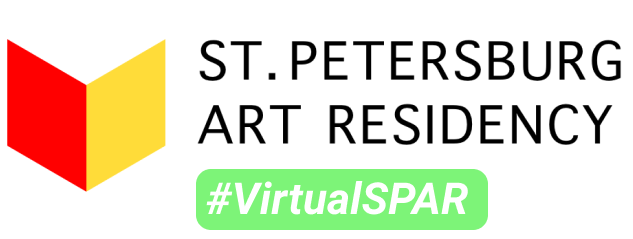Interrupted work – pandemic of change. Ciana Fitzgerald
Lockdown was a time of monumental change, not only in artistic practice but also in terms of relocation and environment. Searching for a safe space to isolate. I had been living and working in Leipzig for the year previous, in a very small flat in an area that we didn’t feel safe in. When the news of an imminent lockdown surfaced, myself and my partner had to make a big decision in a hurry. We had been planning to move to my home country in Ireland later in the year, so our choice was: do we stay here and wait out the lockdown in a space we were unhappy in, or do we move immediately to Ireland where we had a safe spacious place waiting for us in my family home but leave our belongings behind because of the short notice?
We decided to move right then, but I had to make the tough decision of leaving all my work behind in Germany with my partner’s family who live there. It wasn’t possible to take my paintings on my plane and a courier was far too expensive. So here I am sharing my last work interrupted by our move, work that I will reclaim to finish when travel is once again possible and we can be reunited once more. (Apologies for the low quality images, they are screenshots of stills from phone videos I was taking of my progress as I worked)


I was inspired by a photograph my friend took of two nuns crossing a pedestrian crossing in the sunlight to reach the other side of the path enveloped in shade. Ireland has a very fraught history with religious institutions, Catholicism is deeply embedded in our culture and history as it formed the people’s identity when the Irish were suffering greatly under the invasion of the British empire and their punishment of those who attempted to retain aspects of their identity; such as language, religion and values. Therefore it was an important part of unity within individual communities, but in recent years the scandals that have arose from the Church have marred perception of the institution and resulted in dwindling numbers practicing the faith.

Though I was raised Catholic and attended a Catholic school, I would now consider myself generally spiritual instead, rather than a member of a particular doctrine. I am influenced by Irish history in my work and creative process, it is one of suffering and rebellion, and I still enjoy the visual elements of religious art, music and architecture. I find that it evokes a sense of calm and beauty for anyone, not just those associated with it in a fundamental way.


Deeply looking forward to being reunited with my work once more, when I can travel ro Germany to bring it over here to my home. Hope everyone is keeping well and safe X
You Might Also Like:
Van Luong (1)
 Kjell Zillen (4)
Kjell Zillen (4) Mels Dees (9)
Mels Dees (9) Gao Yu (4)
Gao Yu (4)Katya Lebedev (1)
Juan Dies (1)
 Anastasia Prahova (2)
Anastasia Prahova (2)Nena Nastasiya (7)
Taarn Scott (6)
 Cynthia Fusillo (20)
Cynthia Fusillo (20)Roberta Orlando (8)
 Nanda Raemansky (25)
Nanda Raemansky (25) Eliane Velozo (22)
Eliane Velozo (22)Leyya Mona Tawil (1)
Julia Dubovyk (2)
Jianglong (2)
 Iara Abreu (23)
Iara Abreu (23) Agathe Simon (1)
Agathe Simon (1)Rosetta Allan (1)
Elizaveta Ostapenko (5)
 Valentin Boiangiu (2)
Valentin Boiangiu (2) Wesley John Fourie (9)
Wesley John Fourie (9) Renato Roque (3)
Renato Roque (3)Rosa Gauditano (5)
Neerajj Mittra (34)
Ciana Fitzgerald (5)
Boris Moz (3)
 Katerina Muravuova (5)
Katerina Muravuova (5)Kyla Bernberg (1)
 Muyuan He (1)
Muyuan He (1)Liza Odinokikh (2)
 Amalia Gil-Merino (2)
Amalia Gil-Merino (2)Paulo Carvalho Ferreira (6)
 Anastasiia Komissarova (2)
Anastasiia Komissarova (2) Yumiko Ono (1)
Yumiko Ono (1) Stefania Smolkina (1)
Stefania Smolkina (1)Lena Adasheva (1)
 Zahar Al-Dabbagh (1)
Zahar Al-Dabbagh (1) Emily Orzech (6)
Emily Orzech (6) Fernanda Olivares (5)
Fernanda Olivares (5) Noor van der Brugge (3)
Noor van der Brugge (3) Ira Papadopoulou (2)
Ira Papadopoulou (2) Tom Chambers (8)
Tom Chambers (8) Titi Gutierrez (3)
Titi Gutierrez (3) Franz Wanner (2)
Franz Wanner (2) Crystal Marshall (6)
Crystal Marshall (6) Transpositions III (36)
Transpositions III (36) Riddhi Patel (3)
Riddhi Patel (3) Michele Kishita (2)
Michele Kishita (2)Damian Carlton (4)
 Deanna Sirlin (1)
Deanna Sirlin (1) Laura Salerno (3)
Laura Salerno (3) Nina Annabelle Märkl (12)
Nina Annabelle Märkl (12) Elina Fattakhova (1)
Elina Fattakhova (1) Tasha Hurley (1)
Tasha Hurley (1) Ian Hartley (2)
Ian Hartley (2) Laurence de Valmy (2)
Laurence de Valmy (2) Ilia Bouslakov (5)
Ilia Bouslakov (5) Andrea Ahuactzin Pintos (4)
Andrea Ahuactzin Pintos (4) Sveta Nosova (3)
Sveta Nosova (3)Carlos Carvalho (1)
 Maria Timofeeva (1)
Maria Timofeeva (1) Jinn Bug (2)
Jinn Bug (2) Johannes Gerard (3)
Johannes Gerard (3)Irène Mélix (1)
 Aba Lluch Dalena (3)
Aba Lluch Dalena (3) Fabian Reimann (1)
Fabian Reimann (1)Natalia Gourova (1)
 Kate Finkelstein (4)
Kate Finkelstein (4)Raina Greifer (1)
James McCann (2)
Naza del Rosal Ortiz (1)
 Jay Critchley Jay Critchley (1)
Jay Critchley Jay Critchley (1) Vicky Clarke (4)
Vicky Clarke (4) Maria Silva (4)
Maria Silva (4) Shir Cohen (5)
Shir Cohen (5) Peter Shenai (4)
Peter Shenai (4) Bo Choy (4)
Bo Choy (4)Alina Orlov (2)
 Olga Popova (3)
Olga Popova (3) Coco Spencer (2)
Coco Spencer (2) Filippo Fabbri (2)
Filippo Fabbri (2)Daniele Leonardo (5)
 SISTERS HOPE (1)
SISTERS HOPE (1) Scenocosme : Gregory Lasserre & Anais met den Ancxt (4)
Scenocosme : Gregory Lasserre & Anais met den Ancxt (4) Anne Fehres & Luke Conroy (6)
Anne Fehres & Luke Conroy (6) Olesya Ilenok (2)
Olesya Ilenok (2) Marie-Eve Levasseur (4)
Marie-Eve Levasseur (4) Natalia Tikhonova (2)
Natalia Tikhonova (2)Ildar Iakubov (1)
 Evgeniy Lukuta (7)
Evgeniy Lukuta (7) Jarkko Räsänen (5)
Jarkko Räsänen (5)Maria Guta (6)
Egle Kulbokaite Dorota Gaweda (6)
Thomas Kotik (1)
 Andrea Stanislav (3)
Andrea Stanislav (3)Ludmila Belova (1)
Alena Levina (1)
 Ilia Symphocat (2)
Ilia Symphocat (2)Yevgeniy Fiks (1)
Star Smart(Formerly Trauth) (18)
Jyoti Arvey (1)
Les Joynes (2)
 Ekaterina Ivanova (1)
Ekaterina Ivanova (1) Lev Shusharichev (1)
Lev Shusharichev (1)Michael Stebackov (5)
Ryan Griffith (3)
Lidia Gordeenko (3)
 Masha Danilovskaya (7)
Masha Danilovskaya (7) Irina Korotkaya (2)
Irina Korotkaya (2) WagtailFilms Oksana Bronevitskaia&Dmitry Zhukov (5)
WagtailFilms Oksana Bronevitskaia&Dmitry Zhukov (5)Kostya Diachkov (1)
Elena Sokolova (3)
Alexander Nikolsky (2)


2 Comments
Dear Ciana,
This is a delayed reaction to one of your previous contributions:
It touched me to read your piece on Tarkovsky – I feel the same way about his mastership and moral wisdom. Yet I am not a movie buff, not at all, nor do I care much for moving images. Over the past 25 years I did not watch television for more than a few fleeting minutes. The movies I saw during that period were mostly animation stuff I was taken to by my son or by kids living in our street. So I feel, and probably am something like a media troglodyte.
There were and still are reasons for that. My father was a semi-professional filmmaker who often could only see the world, including me, within the frame of his 3:2 camera viewer. Not very helpful for a kid with serious questions about Life, the Universe and Everything.
A bit later I realised that the movies we all consumed then (and now) were taking us by the nose. They led us by force through their stories without allowing any pause to consider the premises, ask questions about, yes: Life, the Universe and Everything. A book allows you to stop reading, reflect, leaf back and – even after a year of thinking or writing an extensive commentary – get on with the next page.
It doesn’t work that way with most (feature) films or video, at least not with me. I tend to feel that I am being deluded, manipulated and that I cannot escape. I get the same feeling with some types of architecture, like haunted houses on fairgrounds and most of those big Ikea Shops (or Libeskind’s Berlin Museum, for that matter). In these spaces you are not allowed to stop and take stock of what you have seen. It’s enough for me to panic.
And I still find it hard to watch an entire movie to its end – except Tarkovsky. Part of the reason must be that their pace is unusually slow. I seem to remember his films (and most others, for that matter) in stills, not as action series. The connections between the images are made in the mind, not as a result of a carefully presented series of actions on screen. Which makes looking at Tarkovsky’s movies so absorbing to me. I remember crying without noticing it myself, at he end of Andrei Rublov.
Almost a year ago, there was a marvellous Tarkovsky exhibition in the Amsterdam film museum. Maybe you saw it – if not, there still is quite a bit of information on the website: https://www.eyefilm.nl/en/exhibition/andrei-tarkovsky
Even though I did not really like it, I was taught to make movies, and edit sound and film. The only film I ever did as an artist was Water, made together with my wife, Mariëlle van de Bergh and the late ballet dancer Lèn Staals. It used to be somewhere on the web, but I cannot find it anymore. You can see some pics here: http://www.mariellevandenbergh.eu/pages/projecten_water.html.
Mels Dees (of course, you can find Mariëlle and me on the Virtual Residency site)
Dear Ciana,
It’s great to get an insight on your working process. Sad to hear that you had to be separated from your works, but I hope everything will be fine, and you will get them back soon (in time for our interview ;)).
It was also interesting for me to learn more about your background and the Catholic education. Did it influence your artistic language and the themes you choose? Or are these just coincidences?